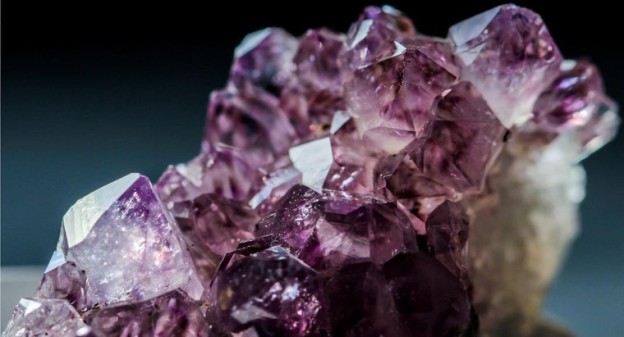The attribution of the magical object of the amethysts began at the same moment that a human being found one; we can imagine his fascination with an object of such a beautiful color, which allows light to pass through it, which is cold at the touch of the hand and which nonetheless possesses the color of the magical violet fire. It is easy to guess, that from the first moment it was considered a special, valuable object that by its beauty could only bring good luck to whoever had it. And the best way to have it permanently would be wearing it, and so, in a simple way, it would be like the first jewels were born, in the form of company, amulet, talisman or fortune mineral. And this magical halo would forge stories and legends that have come and continue to expand, to this day.
Of all its legends, perhaps the most repeated is that related by Aristotle, who attributes to Bacchus, the god of wine, the creation indirectly, of the amethysts, for being persecuting a beautiful young woman who, faced with her harassment and attempted rape, He asked the goddess Artemis for help and she turned it into a vine of violet color, thus preventing it from being violated, (from which comes the word violet, non-violation).
Another form of this same legend is the one that tells that in fact Baco was drunk and persecuted a nymph, named Ametis (from where comes the word amethyst, which also means “not intoxicating”) which used its magical powers to become a beautiful crystal of completely transparent quartz and Baco was so distressed that I spilled the glass of wine that he had in his hand on this crystal, as an offering and an apology and that at that very moment, the crystalline quartz turned into a beautiful amethyst of the color of wine.
As a curiosity, there is a city in Brazil called Amethyst of the South, but this is not the curious thing, not even the obvious fact, by the name, that there are plenty of amethysts there; the curious thing is that the largest church in the town, is built with amethysts and even more curious that each inhabitant took at least one amethyst for its construction, so literally, its walls are lined with beautiful and twinkling amethysts; more than forty tons of amethysts.
Curious also the fact that both these Brazilian and the Uruguayan amethyst can reach more than a hundred million years.
AMETHYST: WHAT IT IS, HOW IT GROWS AND WHERE IT COMES FROM.
Amethyst is a quartz that grows in veins where the presence of ferrous oxide solutions are abundant, specifically a macrocrystalline variety of quartz, which owes its extraordinary color to its chemical composition, mainly iron (oligisto), calcium, boron, aluminum, magnesium and phosphorus among other alkaline components.
If an amethyst is subjected to a temperature higher than 300 / 400ºC, its violet color turns yellow (and it is sold as false citrino)…
With the contact of our skin, the amethyst is heated and its energy, its vibration expands. If we make two amethysts collide with each other, (being in the dark) we can observe that sparks of light jump: these two properties are called piezoelectricity and pyroelectricity, both properties of quartz.
Its energetic vibration is constant, and like all quartz, its energetic effect is balancing and harmonizing.
There are deposits of amethysts in almost all continents, but the most relevant are in: Brazil, South Africa, USA, India, Argentina, Uruguay, Russia and Madagascar. I wish you liked it and that throughout the articles that I will be uploading this week, you will fall in love even more with this extraordinary mineral.
AMETHYST, SACRED FIRE.
For the great majority of the lovers of the mineral kingdom, the amethyst represents the maximum expression of beauty, not only for its form but for the extensive and varied chromatic quality with which we can find it; from the most pale and beautiful lilac, to the deepest and most inspiring purple, the amethyst goes through the whole gamut of violet.
Also, among all the stones considered semiprecious, the amethyst is the one with the most tradition, antiquity, legends, uses and applications.
Zodiac, myth and legend of the Amethyst
The legend of the origin of the amethyst comes from the Greek myth. Dionisio, the god of intoxication, was angered one day by an insult from a human and swore revenge on the next mortal to cross his path. Violent tigers should carry out their desire. Amethyst, a beautiful single girl, on her way to pay homage to the goddess Diana, would become the victim. Diana transformed Amethyst to a pure crystalline quartz stature, to protect it from the brutal claws. Dionysus wept tears of wine, in remorse for his action at the sight of the beautiful statue. The god’s tears stained the purple quartz, creating the famous jewel.
Amethyst is the birthstone for those who were born in February or for the zodiac sign of Pisces.
In ancient times, as well as in the middle Ages, people believed that the cosmos was reflected in precious stones. The amethyst is assigned to the planet Neptune. The esoteric movement rekindled the old belief and the jewelry industry made it another marketing tool, to promote certain gems. The healing powers of gems remain a controversial issue, but they are mentioned for centuries by healers, shamans and medicine men. Whether they are facts or a placebo effect does not matter, if it helps. It is safest to use the stone in contact with the skin in the problematic part of the body. Amethyst is said to be helpful for headaches, back pain and pancreas.

